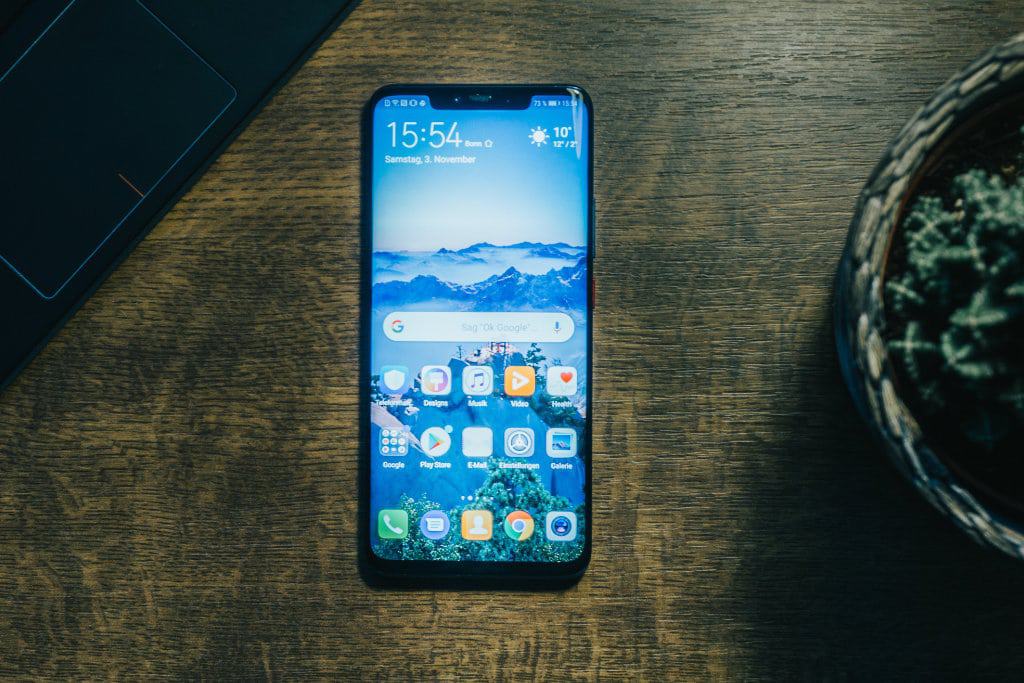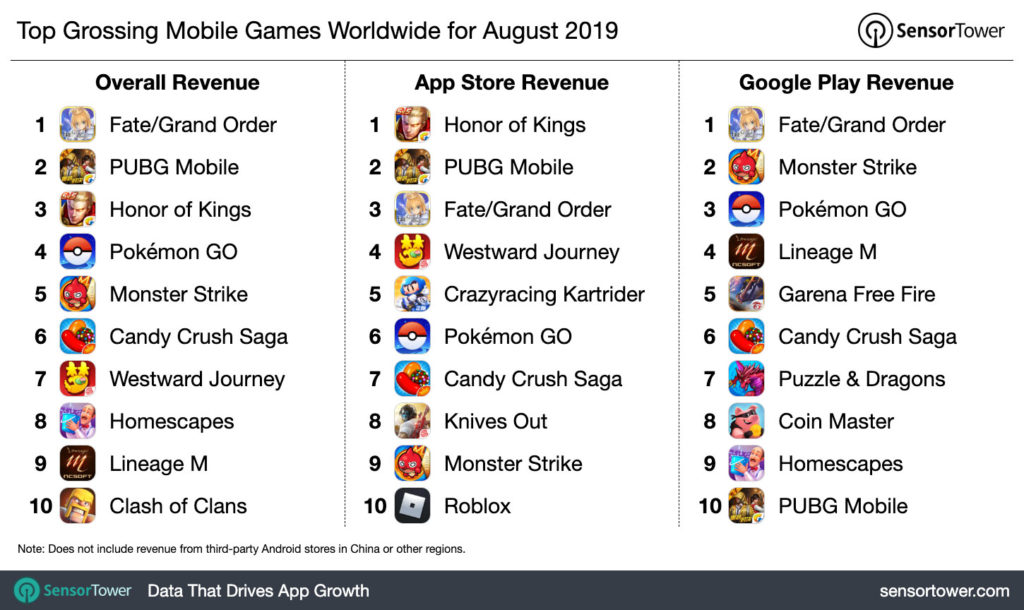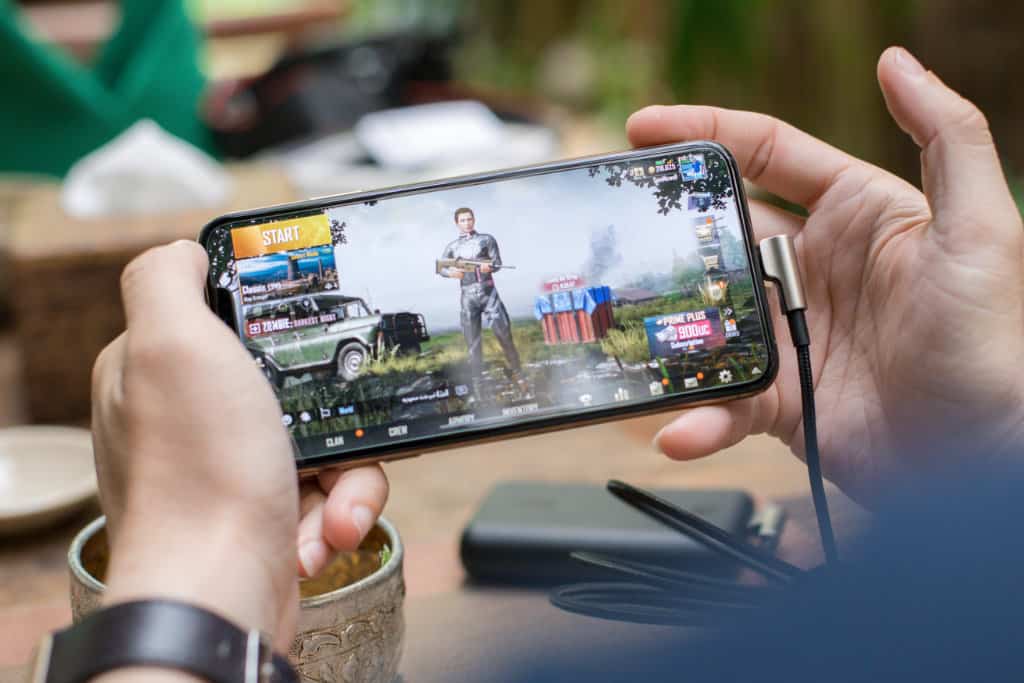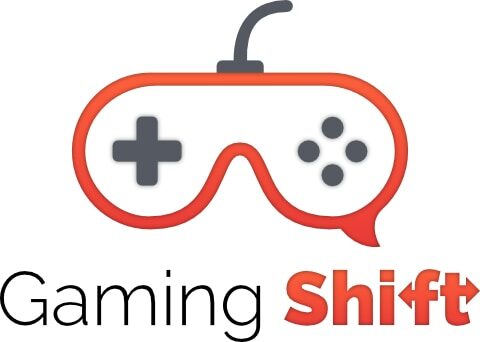Gaming on phones has really taken off in the past decade, and free to play games are the main reason behind this massive surge in mobile gaming. And the quality of free to play mobile games has increased drastically, thanks to giant publishers such as Tencent and Activision. These publishing giants aren’t scared of investing tons of resources to help create breathtaking visuals and smooth animations for games that you can literally play on the go. Just 10 years ago, graphical fidelity of this level was expected only on PCs with the latest hardware. Just look at Call of Duty mobile or Asphalt, and you’ll understand what we mean. MOBAs such as Arena of Valor, Vainglory, etc. offer deep and challenging gameplay experiences that are comparable to their PC counterparts such as League or Smite.
What Do The Numbers Say?
In this article, we will take a look at the 18 main reasons why so many Android and iOS games are free to play. But before that, let’s check out some revenue numbers. According to a Tech Jury article from March 2019, games accounted for 21% of all Android app downloads and 25% of all iOS app downloads. In fact, gaming constitutes 43% of ALL smartphone usage. Mediakix claims there are 2.2 billion mobile gamers worldwide, the majority of whom are present in the Asian region (where Android phones rule).
And if we account for all platforms (PC, mobile, console), free to play games delivered 80% of all digital game revenue in 2018 (not accounting for physical sales such as game disks). A recent report from market research firm Newzoo predicts that mobile games will earn $68.5 billion dollars in revenue across the year of 2019, a majority of which is expected to come in from f2p games on Android and iOS. Sounds amazing, right? Now without further ado, let’s take a look at why free to play games are performing so well.
Android Phones Are Just Cheaper Than iPhones

When Chinese brands like Huawei, Oppo, Xiaomi, Vivo, etc. design phones for countries with low per- capita spending power, they try to keep the MSRP under 250 dollars. Even flagship models cost under 400 bucks, which allows most people from nations like India or Bangladesh to purchase the latest in phone technology. The same philosophy applies to games- if you want to target the largest possible player base, you take away the biggest hurdle to entry which is the initial price of purchase. There is a reason PUBG mobile is so popular in China and India, and it still earned more money than any other mobile game in Q3 of 2019 despite being free. Not only are you targeting low-income households, but also people of all ages- everybody from a schoolkid to their grandparents can play these f2p games. You don’t have to save up pocket money or wait till Christmas so you can ask your parents to buy a game.
And the Google Play store doesn’t force you to link your credit card, which used to be a mandatory requirement for the iTunes store until a few years ago. Bottom line is, the average Android user cannot afford to spend nearly as much money as the average iPhone or iPad user which is why game developers have to create f2p games in order to capture the Android user base. Even if the player doesn’t make in-app purchases, he/ she can add value in other ways- free marketing through word of mouth, watching rewarded video/ interstitial ads, etc.
Game Scarcity Has Decreased, And So Has The Price
This is one of the biggest reasons for cheaper games and the rise of the f2p business model in mobile games. Supply has increased drastically, with thousands of new games entering the app store every month. But publishing and marketing costs have gone down. Think back to the days of Napster, when you could access all the music albums in the world for free without having to spend a single penny on physical disks. Ever since Steam revolutionized the digital game distribution market, it has become easier for developers to create and publish games without having to be part of a larger company. Apple led the way with its App Store, and Google’s Android OS has Google Play. You don’t have to rely solely on publishers. As long as you have an interesting idea there’s a platform to publish, monetize, and market it for free. With Google AdMob, you can easily integrate ads into your f2p game. Check out our article on how to use Google Admob if you are interested in monetizing your apps.
Piracy Is A Major Concern, Especially On Android
One of the things that makes the Android platform so amazing is its customizable, open-source design. But this also creates certain weaknesses, ones that affect game developers. It is much easier to sideload an APK onto your Android phone, compared to iOS which makes it much more complicated to obtain games illegally. One example of this behavior is documented within this Business insider article from 2015. In the article, Ustwo Games which is the developer of “Monument Valley” states that only 5% of Android installs were paid for (legitimate purchases). In comparison, 40% of iOS installs were paid for. Clearly, piracy isn’t just an Android thing, but it is definitely a much larger issue on Google’s platform compared to iOS. The same reason so many developers these days launch on console first, because they know that the PC versions will get cracked eventually (and that is why we have intrusive DRMs like Denuvo on PC). So developers can either risk getting zero money from a user by making the app paid, or get something out of players via in-app purchases and ads. It is true that individuals players in a f2p game aren’t as valuable from a monetary standpoint, but the potential for income is still better when compared to making no money at all.
They Are Often Easier To Develop

Development costs are lower for games with relatively simple artwork and animation, and the turnover time for new updates or patches is also reduced. You can churn out a simple f2p game without spending tens of thousands of dollars learning game development at some prestigious school. You can work with a smaller team, and don’t require people with several years of experience. Often times, the software required to create such games is either open source or really cheap compared to industry-standard tools used for creating high budget games in AAA studios. And assets such as 3D models, sprites, VFX, levels, etc. can be obtained for free thanks to online repositories such as Itch.io and Free3D.
If you wish to know how games are made, you can check out my post How Mobile, PC, Console Games Are Made?
The Games Are Actually Pretty Good
Those of you who are above 30 years of age might remember playing “Snake” on your Nokia 3310 handset. A simple 2D game in black and white with pixelated graphics, which was pretty revolutionary back then. But times have changed, and screen resolutions have gone far beyond 240 x 320. We don’t have black and white displays anymore, most decent phones these days have IPS or OLED panels with HD+ resolutions which rival TVs in terms of picture quality. And the modern Snapdragon or A- series Bionic chips beat out PC CPUs from a few years ago in terms of processing power. All these advances in tech mean we aren’t limited to pixelated graphics and simplistic level designs anymore. We can create full-on 3D open-world AAA quality games for mobile phones, which people can play on the go. And with technology like AR, we are taking mobile gaming into a different dimension (just look at how successful Pokémon Go was). Now you can play PUBG, Fortnite, Call of Duty, etc. while flying 30,000 feet above the ground in a jetliner. It is truly a miracle that we are able to experience such gameplay depth and graphical fidelity within free to play games, on a device that we can carry inside our pockets.
The Social Component
One of the major drawbacks to social experiences on single-player paid games is the initial cost of purchase. Say you really enjoy a game, and wish to share it with a friend. Unless the game has some form of a split-screen co-op mode for local multiplayer, your friend has no choice but to purchase his own copy (that is IF the game even has co-op). On the contrary, most f2p games on mobile have some form of online multiplayer/ co-op built-in. Since there is no barrier to entry as these games are free, all you have to get your friend to install the game. And most of the games make it easy by having their own built-in social network which lets you add friends, invite them into matches, share items, etc. Having multiplayer adds an additional layer of depth to the game, which means you don’t have to spend your development budget on a captivating single-player story mode. This lowers development cost and gives your game more longevity. The social component in f2p games also means developers don’t need to spend as much money on advertising campaigns, the players will do it for free. Just look at the most popular f2p mobile games- Candy Crush Saga, Pokémon Go, PUBG Mobile, etc. All of these games have some form of social interaction built-in.
You’ll Keep Coming Back For More
Basically, these games are designed to “hook” you and transform you into a regular player. Like a gambling addict in search of a slot machine, your brain keeps on nudging you to play just one more match of PUBG or another level of Candy Crush. Bright colors, stylistic visuals, unlocking achievements, rewards, timed events, etc. are mechanics put into f2p games that entice the player to keep coming back. Eventually, 1 out of 1000 will make their first in-app purchase, at which point they are deeply invested in the game and it becomes even harder for them to uninstall or quit. Just having more active people playing the game is enough for developers to justify updating and maintaining their f2p game.
If you wish to know more how to make addictive games, then check out my article 19 Points For Making Unbelievable Addictive Mobile Games
Free-To-Play Mobile Games Create Their Own Economies

Often times, you will see gaming journalists and players compare the value of one paid game to another. How long was the campaign? Was there enough post-story content? What about expansion packs and DLCs? Were the side quests good? When two console games cost 60 dollars each, it is easy to make these comparisons and provide an objective take on which is better value for your money. But with a f2p game that costs zero dollars for the buyer, you have to create value subjectively. Basically, how much are certain in-app purchases worth to YOU? You see, f2p games have their own built-in economies. And you judge the value of a cosmetic item or gameplay affecting upgrade based on things like- how much YOU like the game, how much time YOU put into playing the game, etc. This allows people to justify spending more money than the price of your average paid game. This is also the reason “whales” exist, users who spend hundreds or even thousands of dollars on in-app purchases for a single game. If the in-app monetization is too greedy, your game will simply turn off players. If the in-app monetization is too generous, you won’t make money. So it is a fine balancing act, games that get this balance right continue to make millions over a period of years.
The Market For Such Games Is Extremely Lucrative
This ties into the previous point that we made- as long as people keep coming back daily and open up the game, the chance of getting a paying player increases ever so slightly. The major draw of a f2p business model is its low cost of entry and a higher chance of capturing large player bases compared to paid games. By removing that initial hurdle for players, you guarantee that a lot more people will install your game. Instead of making a fixed 5 dollars on your game, you can now collect anywhere from 0.99 to 5000 dollars per user. Just look at the top-earning mobile games of recent times- PUBG mobile revenue grew 652% year-on-year, generating $496 million USD for Q3 of this year. Arena of Valor, an extremely popular MOBA brought in $377 million in the same quarter, and Niantic’s Pokémon Go is still going strong with revenue figures up by 63% quarter-over-quarter. Take a look at the top charts of mobile games provided by sensor tower and you’ll notice that almost every chart-topper in recent times is a f2p game.

Easy In, Easy Out
The cool thing about digital distribution is the ease with which you can iterate upon your game design, by releasing gameplay updates and patches. If you have an innovative concept for a new mobile game but fear that it may not catch on with the player base, you can make a soft launch in certain specific countries with a limited set of features enabled. Lower development costs, less risk involved. If the game is a success within your test demographic, you can ramp up development costs by hiring new animators, sound engineers, programmers, etc. and release a full version. By using the games as a service business model, you can choose to quit whenever the time and money being invested isn’t worth it. You can experiment with different types of ads, tune the cost of in-app purchases, and basically create a giant pool of playtesters by making the game free. Your community will provide you with feedback on how to balance or improve the game which further lowers development cost.
Simplistic Mechanics And Eye-Catching Visuals
The success of Angry Birds, Clash of Clans, Hearthstone, etc. has proven that you don’t need realistic graphics and super detailed character models to attract an audience. Your game has to be fun first, realistic/ visually detailed second. And a lot of successful f2p mobile games have relatively simple game mechanics, which makes it much easier for casual players to get onboard. You don’t have to spend several hours understanding Candy Crush, or Bejeweled. And if you play Clash of Clans, you will notice the big fat fonts with bright colors combined with intuitive tutorials and wacky sound effects that immediately grab your attention. Whenever you do something right, the game provides you with positive feedback in the form of gold coins jumping out on the screen, or a message displaying “Well Played!” that lets you know you’re on the right track.
Customizable Characters And Purchasable Advantages

Who doesn’t want to live a power fantasy in their favorite shooter or action game? You come home after a long day of work at the office, tired of listening to other people telling you what to do and how to do it. You pick up the phone and are finally ready to pwn some noobs in the battle royale of your choice. As soon as the game launches, your screen flashes brightly as a limited time discount for a special rifle pops up. Why spend 2 weeks grinding for that weapon when you barely get 1 hour of free time a day? The people with more money than time will simply give in, and press “buy”. Your village got destroyed by an enemy raid in Clash of Clans? Just spend money on gems to buy elixir and speed up the rebuilding process. A lot of players don’t want a fair fight, and just desire to be better than the rest. More levels, better skins, powerful weapons, etc. can be purchased if you open up that wallet for just a few seconds. And those players who are engaging in fair play often get destroyed by enemies who just spent money. Which then spurs these players on the receiving end of the beating into spending money themselves. It is a chain reaction.
Free To Play Games Bait You Into Spending Money With Psychological Tricks
One of the first things that any f2p game does, is to replace real currency with virtual currency that is unique to the game. By doing so, they trick you into believing that you aren’t spending real money. Studies have shown that people are more reluctant to spend money if they are paying with cash. But they are more likely to spend money while using a credit card. And f2p games take this one step further by including different types of virtual currency- primary that can be purchased with real money, and secondary which you can purchase with primary game currency. For example, you use your credit card to buy gold coins and then you can use these gold coins to purchase purple hearts which are required to obtain life boosters, weapon upgrades, etc. At this point, you are so detached from the fact that you’re spending real money, that you will just go along with it. Another trick f2p games use is analogous to how you would spend money as a tourist when visiting a foreign country. Say a box of armor-penetrating ammo costs 50 blue cookies and $3.99 gets you 600 blue cookies, how much real-world currency does a box of ammo cost? Yeah, most people won’t do the math and they just buy it. Besides, it is extremely easy to spend a ton of money really fast with the press of one button since the app store already has your credit card linked. While the payment process itself is designed to be seamless, certain parts of the game are designed to be tough for those who want to grind their way without spending a single dollar.
Players Do The Advertising For You
One of the big challenges involved with releasing a brand new game that nobody has heard of is getting people to play it. Big-name studios and publishers have the ability to spend more money on ad campaigns, and they have established IPs which gamers are already familiar with. But as long as your game is good, the players will do most of the advertising. It is even better if you integrate social components into the game such as leaderboards, friend requests, co-op/ multiplayer, etc. which will motivate players to compete against each other. People who like the game will be able to share it on social media. In fact, a lot of f2p games have social media sharing built-in.
Successful F2P Mobile Games Have Paved The Path For Newcomers
Wargaming, the Belarusian giant behind World of Tanks and World of Warships has now set its sights on the mobile AAA market. Nexus, a new branch of Wargaming will focus on developing smash hits for the Android and iOS platforms (they are interested in shooters). Inspired by the success of games such as COD mobile, PUBG, Fortnite, etc. companies like Wargaming are now shifting their sights towards the ever-growing mobile gaming market which is expected to rake in $68.5 billion this year. Newzoo predicts that mobile will account for 45% of the predicted $152.1 billion in total revenue generated by gaming in 2019. And by 2020, mobile will constitute 59% of the total gaming revenue. While premium games are still performing well in Western markets, Asia is all about f2p. And the most popular games with the largest install bases are driven by Asian mobile gamers. The success of Pokémon Go, Candy Crush, Hearthstone, Fortnite mobile, etc. has told publishers that their games as a service model are working brilliantly. One by one, everybody is jumping on the f2p hype train which is only going to get bigger.
Mobile eSports

After PC and console esports, competitive mobile gaming might be the next big step in pro gaming. We already have various tournaments for PUBG mobile, one of the largest being PMCO (PUBG Mobile Club Open). There is a prize pool of $500,000 up for grabs, which will be distributed among 16 teams playing in the tournament. Mobile Legends, Clash Royale, and Honor of Kings have their own esports scenes. Whether or not you’re interested in competitive gaming, you have to admit that this is a really nice opportunity for more people to get into the world of esports and a great way for companies to market their free to play games towards a broader audience. These esports tournaments are essentially giant marketing campaigns intended to promote the game among people of all age groups, and they also provide lucrative career opportunities for the best players out there.
If you wish to learn more about eSports, then check out my post What Is Esports? How Big Is It? How Much Money Can You Win? Written by Jacob in Gaming
Innovation Combined With Proper Timing
Constant improvements in hardware, processing power, sensor technology, and peripherals have transformed the smartphone into a gaming device that should be taken seriously as a potential contender against home consoles. Pokémon Go got the whole world moving with its creative AR system that encouraged people to scan every nook and cranny of their real-life neighborhood for magical creatures. Certain games are also capable of using the facial scanning system on your phone to personalize your in-game character, and you can even input voice commands. Gaming on the go is even easier thanks to Bluetooth controllers designed specifically for mobile phones, and high refresh rate displays which enhance the competitive gaming experience on shooters or fighting games. As mobile devices get even more powerful, developers will have all the creative freedom in the world to design a game that is less of a “mobile game” and more of just a game like you would experience on your console or PC. Puzzle games and super casual games are extremely popular now, but the industry will diversify to meet the demands of more serious gamers who want a true AAA experience on the go. Possibilities are endless, and whoever comes up with the next groundbreaking idea for a f2p game will take over the market as Fortnite and Pokémon Go have done.
You’ve Got Nothing To Lose
Thanks to digital distribution via app stores, you can now browse between various genres of games from different publishers with relative ease and download whatever catches your eye. If it works out, great. If not, you just swipe it away into the trashcan and move on. That is the beauty of f2p games, you as the player have nothing to lose except a few minutes of your time. No need to spend money on an initial purchase and a lot of f2p games don’t even ask you to register or link your social media accounts. They want to make the onboarding process as simple as possible. Most importantly, you can read user reviews, view screenshots, and watch playthroughs on Youtube before you install the game.
Conclusion
Smartphones are a mainstream technological device, and almost everybody living in modern society owns one. You get access to so much knowledge, stay connected with friends and family, read the news, watch movies, and do so much more. But gaming is what most casual users will spend the majority of their time on while using a smartphone. And with faster processors, high refresh rate screens, more RAM, faster storage, etc. mobile games are starting to get better and better. We are now at the point where VR gaming on your phone can be considered a plausible reality within the next couple of years.
Since the free to play genre is still dominant over premium mobile games, you can expect the point of entry to be affordable for all these new experiences. Not saying that the f2p model is perfect, it certainly has its flaws. Like oversaturation of the store with games, some of which are plain asset flips. And then there is the issue of whales- a tiny percentage of the player base which supplies the majority of revenue by spending on in-app purchases. Certain game developers knowingly target these “whales” with lucrative offers such as limited-time discounts on in-app currency, exclusive items, new cosmetics, etc. at the expense of making actual gameplay improvements which is what the rest of the player base desires. And since the expectations of players have gone up thanks to all these high-quality f2p games from big studios, it makes life much harder for startups with a low budget to enter this extremely competitive market. Balancing a good player experience with sustainable monetization is tricky business, and we are still a long way from developing the perfect business model for f2p games.
So, what did you think of our list? Do you agree with the points we made, or would you like to add something to the discussion? Please let us know in the comments below, and as always- thanks for reading.
